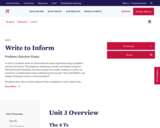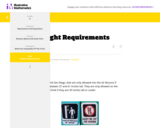
In Unit 2, students continue to read the anchor text, The Boy Who Harnessed the Wind, beginning at chapter 11. As William formulates a plan for a windmill to generate electricity and ease some of the burdens caused by the famine, students examine how he applies design thinking to solve his problem. Using a graphic organizer to collect evidence of William’s problems and solutions, students build understanding of the cyclical nature of design thinking and the way the authors develop this key idea with specific details. For the mid-unit assessment, students read a new informational article about another solution designed to solve a critical problem. Students answer selected response questions about figurative and connotative meanings of words in the text and about the way that key ideas are developed. Students also write an objective summary of the text, identifying its central idea and the details that convey it.
In the second half of the unit, students finish reading the anchor text and launch their research project. Inspired by a curated list of TED Talks, students choose a different invention designed to solve a critical problem. The research process is broken down into a series of mini lessons that teach students how to gather evidence from multiple sources, evaluate a source for credibility, and paraphrase or quote from the source with accuracy. For the end of unit assessment, students demonstrate their understanding of the research process by gathering more information from the text studied during the Mid-Unit 2 Assessment. Their tasks include refocusing their search for more relevant results, determining the credibility of possible sources, paraphrasing responsibly, and providing basic bibliographic information for sources.
- Subject:
- English Language Arts
- Material Type:
- Unit of Study
- Provider:
- EL Education
- Date Added:
- 05/17/2024




